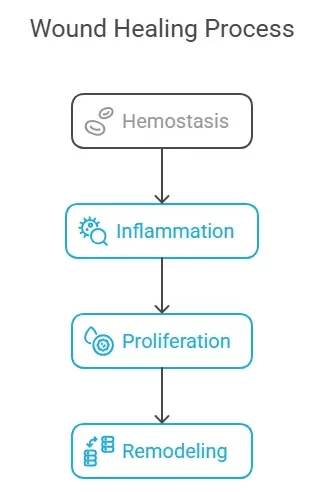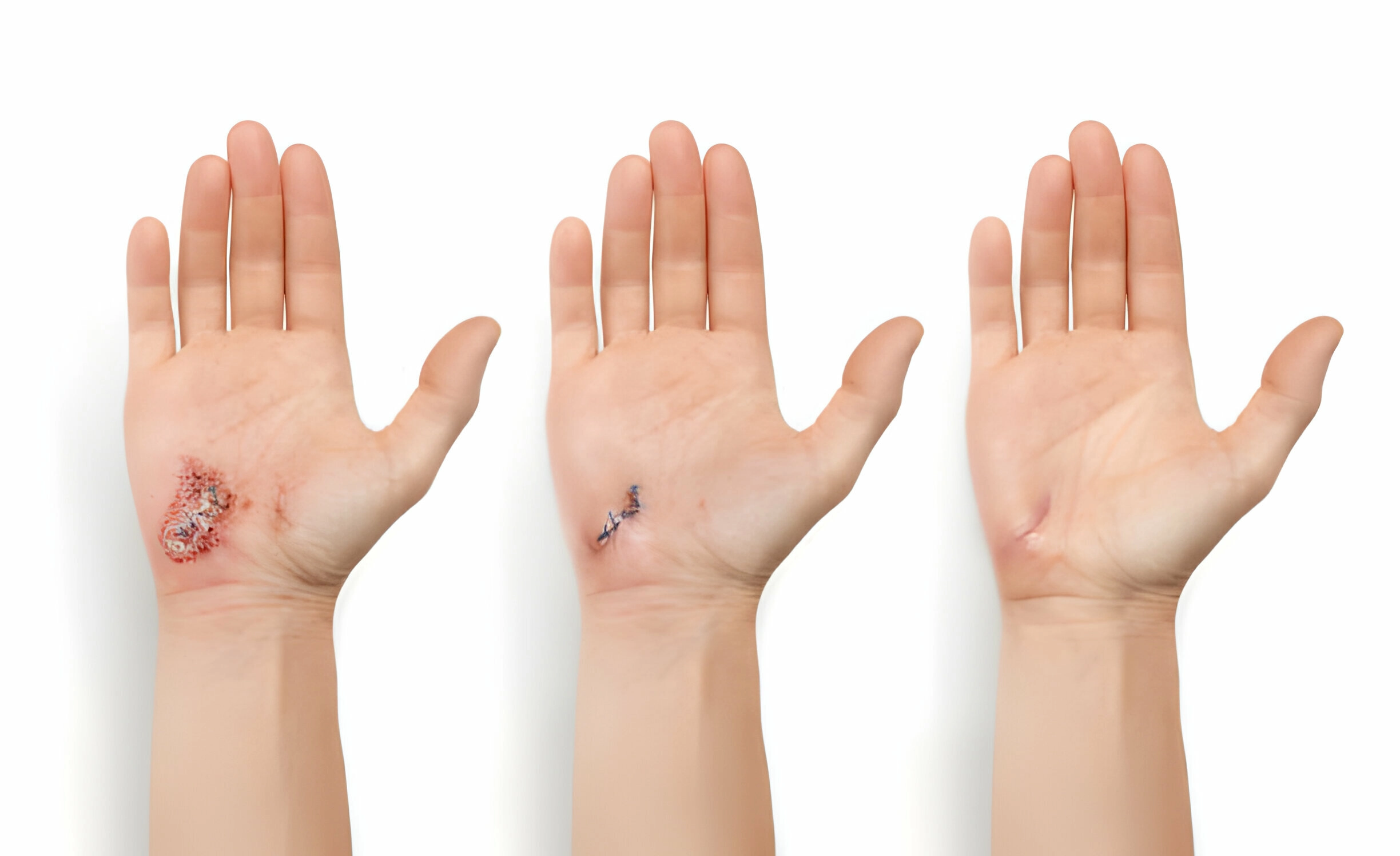Definition
the process of repairing damaged or destroyed tissue. It is a complex process that involves a variety of cells, including fibroblasts, keratinocytes, and endothelial cells.
process of healing :

The wound healing process consists of four interconnected phases:
Hemostasis: This initial response involves vasoconstriction, platelet aggregation, and fibrin clot formation to prevent excessive blood loss.
Inflammation: Characterized by immune cell activity, this phase focuses on destroying pathogens and removing debris, creating a foundation for subsequent healing phases.
Proliferation: Also known as the regenerative phase, it includes granulation tissue formation, angiogenesis, and collagen deposition, crucial for re-establishing tissue continuity.
Remodeling: The final phase involves maturation and reorganization of connective tissue, restoring vascular integrity and strengthening the wound site.
TYPES OF WOUND HEALING
Wound healing involves three primary types:
Primary Intention Healing: Applied to clean wounds closed surgically, with minimal tissue loss and well-aligned margins, resulting in faster healing, lower infection risk, and minimal scarring.
Secondary Intention Healing: Used for wounds with significant tissue loss, where natural healing involves granulation tissue filling the defect and wound edges contracting. This method results in slower healing with potential for significant scarring.
Tertiary Intention Healing: Combines primary and secondary methods. Initial secondary intention healing is followed by surgical closure, making it suitable for wounds at high infection risk or when immediate closure isn’t possible. This approach manages contamination risk and
EPIDEMIOLOGY
Epidemiology of Wound Healing:
- Global Prevalence: Approximately 30 million chronic wounds worldwide; WHO reports over 100 million people globally suffer from chronic wounds.
- Risk Factors: Include age, medical conditions, malnutrition, obesity, and smoking.
- Types of Wounds: Categorized into acute (healing within 6-4 weeks) and chronic (lasting over 6 weeks).
- Common Causes: Trauma, surgery, burns, diabetes, and vascular disease.
Prevalence in Middle East and GCC:
- Chronic Wounds Prevalence: Around 10% in the Middle East and GCC, higher than the global average of 5-2%.
- Common Types of Wounds: Diabetic foot ulcers, pressure sores, and venous leg ulcers.
Contributing Factors in Middle East and GCC:
- High Diabetes Prevalence: A major risk factor for wound healing problems.
- Aging Population: Older adults are more prone to wound healing issues.
- Obesity Prevalence: Higher rates in these regions contribute to wound healing problems.
- Limited Healthcare Access: Challenges in obtaining necessary care.
Significance of Wound Healing:
- Public Health Concern: Causes morbidity, mortality, and high healthcare costs.
- Quality of Life Impact: Leads to pain, discomfort, mobility issues, and social isolation.
- Economic Burden: Results in billions of dollars in annual healthcare expenditures.
PATHOPHYSIOLOGY :
Hemostasis Phase: Immediately after an injury, the body initiates hemostasis to prevent excessive blood loss. This involves vasoconstriction, platelet aggregation forming a plug, and the coagulation cascade leading to fibrin clot formation.
Inflammatory Phase: Characterized by the body’s immune response, the inflammatory phase aims to prevent infection and break down damaged tissue. Vasodilation and increased permeability facilitate the arrival of immune cells, with neutrophils removing debris and bacteria, followed by macrophages clearing the wound and releasing factors promoting tissue repair.
Proliferation Phase: During proliferation, the wound rebuilds with granulation tissue. Fibroblasts produce collagen and extracellular matrix, forming new tissue. Angiogenesis creates new blood vessels, supplying oxygen and nutrients, while epithelialization involves migration of epithelial cells to form a protective barrier.
INTEGRATION OF TISSUE ENGINEERING FOR WOUND HEALING :
Initial Wound Care (1-0 week):
- Interventions: Apply antimicrobial and moisture-retaining dressings.
- Rationale: Protect the wound from infection and create an optimal environment for cell migration and proliferation.
Proliferation Phase (3-1 weeks):
- Interventions: Utilize growth factor therapies, bioengineered tissue constructs, or scaffold-based therapies.
- Rationale: Enhance tissue growth, especially in large or chronic wounds, to support the healing process.
Remodeling Phase (3 weeks to 2 years):
- Interventions: Implement long-term strategies such as collagen-based products or continued use of advanced dressings.
- Rationale: Ensure the formation of strong, resilient scar tissue and minimize the risk of wound reopening.
Long-Term Care and Monitoring:
- Interventions: Provide ongoing care with appropriate dressings or therapies.
- Rationale: Maintain skin integrity, prevent recurrence, especially in vulnerable populations like the elderly or those with chronic diseases.
Case Studies (Before&After)


